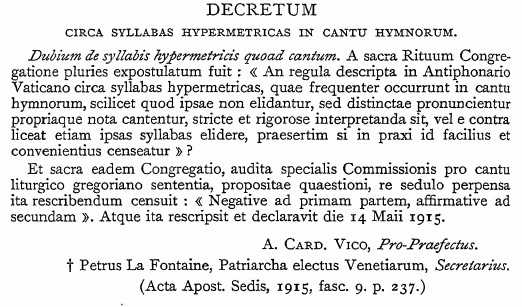Hypermetric scruples
-
Occasionally in classic Latin hymns we find texts that don't fit the poetic meter perfectly but have an extra syllable, and these are often notated so as to draw attention to the discrepancy, as here ("digitus") in the Veni Creator Spiritus:

Some choir directors adjust these "hypermetric syllables" to fit the meter: that is, they may "elide" syllables by omitting the vowel of one syllable and combining the rest of that syllable with the next (or the previous one!). For example, in the doxology at the end of a long-meter hymn, the phrase "cum Patre et almo Spiritu" can be sung in eight syllables as "cum Patr-et almo Spiritu". On the other hand, some choir directors sing these lines exactly as notated, out of a sense of duty to sing the hymn as directed in the church-approved book.
Today I stumbled on this document in the old (1949/1960) Antiphonale Romanum (page 64*), which addresses the scruple about what is permitted.
The question addressed to the Congregation of Rites (back in 1915) was whether these lines should be pronounced distinctly and the added notes sung rigorously as indicated in the Antiphonale, or whether it was permitted to elide those syllables; and the answer from the Congregation came back, "Negative to the first part; affirmative to the second"; that is: it is not required to interpret those lines rigorously, and it is permitted to elide the affected syllables.
I hope this helps ease anyone's worry about what is suitable and permitted.

 hypermetric.jpg522 x 307 - 70K
hypermetric.jpg522 x 307 - 70K
 veni-creator-3.jpg575 x 169 - 38K
veni-creator-3.jpg575 x 169 - 38K -
Didj-toos is one I'd need to sleep on, I think.
-
Or you could do two shorts (eighth notes)… but you would have to alert everybody to the fact
-
And then, there is the problem(?) of the first line of Adoro te devote having 12 syllables instead of the 11 syllables present in every other line of the hymn. The usual solution is to have -ro te sung on separate notes (and hence not jammed into one note or sung to two half-length notes).
-
As someone who regularly sings Vespers: the Solesmes 1934 solution is the best, wherein the notes are never doubled, but for reasons I don’t ever amend my scores to omit the note. One, it makes it more portable if someone else wants to use the file. Two, sometimes, as in the last verse of the Veni Creator, the note is not an extra note, but rather a neume divided into two.
The custom of the trad communities as far as I can tell is always to elide — this creates problems particularly in the Veni Creator if the faithful are not given clear directions in some way.Thanked by 1CHGiffen
Welcome to the MusicaSacra Forum!
To participate in the discussions on Catholic church music, sign in or register as a forum member, The forum is a project of the Church Music Association of America.
Categories
- All Discussions21,093
- General Music Discussion8,210
- Job Openings195
- Management of Music Programs850
- Choral Matters532
- Church Documents and Rubrics524
- CMAA Notes301
- Events716
- For Newcomers: Read First26
- Sacred Polyphony546
- Hymnody872
- Gregorian Chant: General2,697
- ↳ Graduale Romanum and Liber Usualis368
- ↳ Graduale Simplex60
- ↳ Semiology63
- Vernacular Plainsong696
- Anglican Use and Anglican Chant68
- Organ, Other Instruments and Repertoire435
- New Composition/Works in Progress1,290
- Recordings230
- Music for Hispanic Ministry159
- Music Education: Children211
- Music Education: General222
- News Items245
- Positions Wanted2
- General Discussion: Catholicism739
- Amusements177
- General Discussion1,033
- Opinions117



